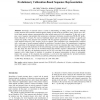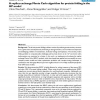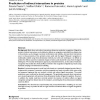50 search results - page 7 / 10 » Prediction of protein subcellular location using hydrophobic... |
BIBE
2005
IEEE
14 years 1 months ago
2005
IEEE
Prediction of protein tertiary structure based on amino acid sequence is one of the most challenging open questions in computational molecular biology. The two most common experim...
JCC
2008
13 years 7 months ago
2008
: Knowledge of structural classes is useful in understanding of folding patterns in proteins. Although existing structural class prediction methods applied virtually all state-of-t...
BMCBI
2007
13 years 7 months ago
2007
Background: The ab initio protein folding problem consists of predicting protein tertiary structure from a given amino acid sequence by minimizing an energy function; it is one of...
BMCBI
2006
13 years 7 months ago
2006
Background: When accurate models for the divergent evolution of protein sequences are integrated with complementary biological information, such as folded protein structures, anal...
BMCBI
2006
13 years 7 months ago
2006
Background: Both direct and indirect interactions determine molecular recognition of ligands by proteins. Indirect interactions can be defined as effects on recognition controlled...



